Pressure groups, also known as interest groups or advocacy groups, are voluntary organizations aiming to influence government policy and legislation without seeking formal political power. Representing diverse interests, they act as intermediaries between the government and their members, striving to protect and promote specific concerns through various techniques like electioneering, lobbying, and propagandising. These groups are crucial in shaping public policy and ensuring that various societal interests are articulated and addressed by the government.
According to Richard D. Lambert, ‘These are unofficial governments, which implies that no government can run without taking their viewpoint into consideration’.
Enroll now for UPSC Online Course
Pressure Groups: Their Role and Influence in Modern Politics
Definition and Purpose of Pressure Groups
- Definition: A pressure group refers to a voluntary organisation that seeks to influence government policy or legislation without seeking formal political office.
- Alternative Names: These groups are also known as interest groups, lobby groups, advocacy groups, or special interest groups.
- Scope and Interests Represented: They represent a variety of interests and beliefs, including economic, environmental, social, cultural, and political concerns, leading to them being termed as “Legislatures behind Legislatures.”
- Role as Intermediaries: It acts as an intermediary between the government and its members.
- Non-Political Ambitions: Pressure groups, also referred to as interest groups or vested groups, do not participate in elections or attempt to seize political power.
- They are concerned with specific programmes and issues.
- Primary Function: Interest Protection and Promotion: Their work is to protect and promote the interests of their members by influencing policy-making and policy implementation in the government.
- In short, they play the role of ‘interest articulation’.
Techniques or Methods of Pressure Groups
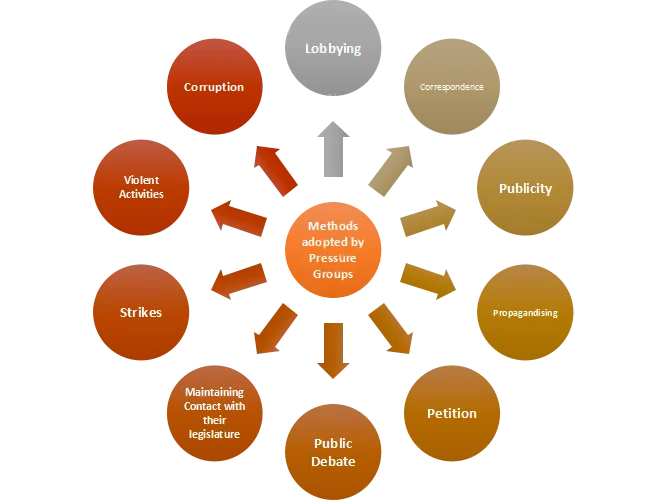
Pressure groups employ three distinct techniques to achieve their objectives
- Electioneering: They can try to place in public office persons who are favourably disposed towards the interests they seek to promote. Electioneering can be active or passive.
- Example: Funding the election of a favoured candidate, contesting elections by trade unions, and farmer leaders under the banner of political parties. Swaraj Dal is one such example.
- Lobbying: They may attempt to convince public officers, whether or not they are initially inclined in their favour, to adopt and enforce policies that they believe will be most advantageous to their interests.
- Alcohol and Tobacco-based industrial groups are lobbying against legalizing the use of cannabis in India.
- Propagandising: They can try to influence public opinion and thereby gain an indirect influence over government since the government in a democracy is substantially affected by public opinion.
- Example: the Army’s Control over the governments of Pakistan and India against corruption etc.
Basic Characteristics of Pressure Groups
- Based on certain interests: Each pressure group has their own certain interests and tries to impose its views on the political structure.
- Example: the Republican party (USA) is often influenced by industrial pressure groups to ban imports and promote exports.
- Adoption of Modern and Traditional Methods: Pressure groups use strategies like funding political parties and keeping the bureaucracy on their side via any means.
- Example: Modern methods include tractor rallies, social polls, financing of political parties, media trials, etc. Traditional Methods include Union Ideology, Mahapanchayat, Blockade of roads, market etc.
- Competition for Resources: The scarcity of resources, claims, and counterclaims on available resources from different sections of society fuel the growth of pressure groups.
- Example: Pressure groups under the banner of Save Hynniewtrep Mission staged a protest against the business expansion of outsiders in Shillong.
- Inadequacies of Political Parties: Interest groups are mainly a result of inefficiencies and failure on the part of political parties in addressing the issues of the citizens.
- Example: the Humsafar Trust and Naz Foundation took up the issues of the LGBTQ community as political parties failed to come forward.
- Symbolise the changing consciousness of society: The consciousness of groups changes with time and the needs of society. Thus, the pressure groups represent a new set of values.
- Example: Mazdoor Kisan Shakti Sangathan promoted values like transparency which led to the enactment of the RTI Act 2005.
Types of Pressure Groups
| Institutional Interest Groups | Associational Interest Groups | Anomic Interest Groups | Non-Associational Interest Groups |
|
|
|
Rashtriya SwayamSevak Sangh (RSS), Vishwa Hindu Parishad (VHP), Tamil Sangh, etc. |
They can also be classified into
- Formal pressure groups:
- These groups are organised entities with defined structures, membership, and specific objectives that actively seek to influence political decisions, policies, or institutions through various means.
- This includes professional associations, trade unions, advocacy organisations, and special interest groups, which have organised structures, memberships, and specific goals to influence political decisions and policies.
- Informal pressure groups: These groups are loosely organised associations without formal structures or memberships that work to influence political decisions or policies.
- Example: grassroots movements, online communities, and ad-hoc activist groups. These entities may not have established hierarchies or official memberships but can still exert influence through collective actions and shared interests.
Pressure Groups in India
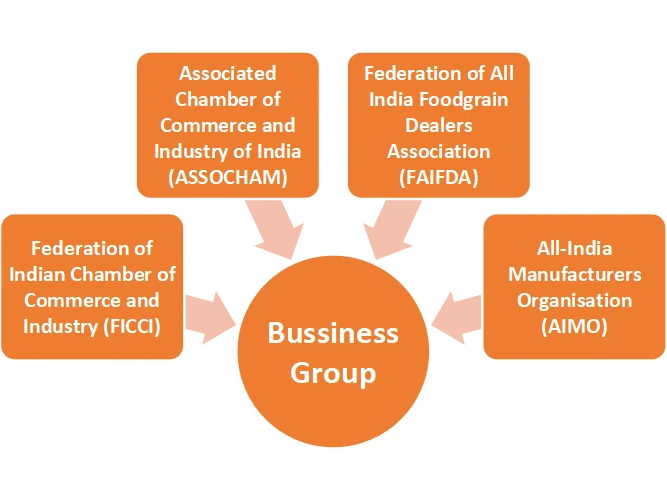
India has a considerable number of pressure groups, although they are not as developed as those in the US or Western countries such as Britain, France, Germany, and so forth. Pressure groups in India can be broadly categorised into the following groups:
- Business Groups: These groups include a large number of industrial and commercial bodies and are the most sophisticated, the most powerful, and the largest of all pressure groups in India.
- Trade Unions: Trade unions articulate the demands of industrial workers. Trade Unions are also known as labour groups.
- Trade unions in India are associated either directly or indirectly with different political parties.

- Agrarian Groups: The agrarian groups represent the farmers and the agricultural labour class.
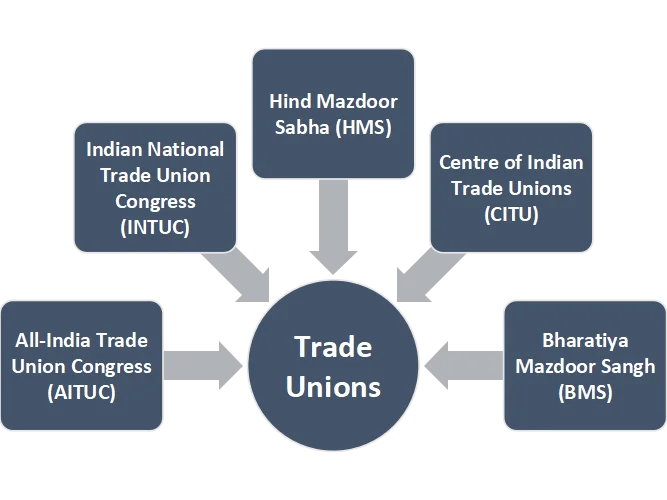
- Professional Associations: These associations raise the concerns and demands of doctors, lawyers, journalists and teachers.
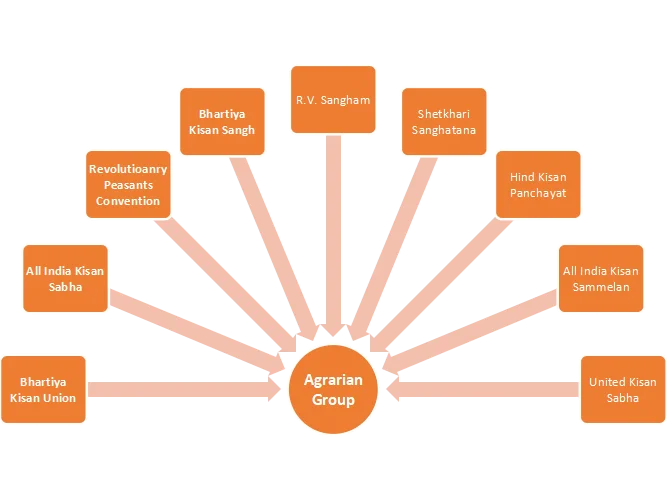
- Despite various restrictions, these associations pressurise the government by various methods including agitations for the improvement of their service conditions.
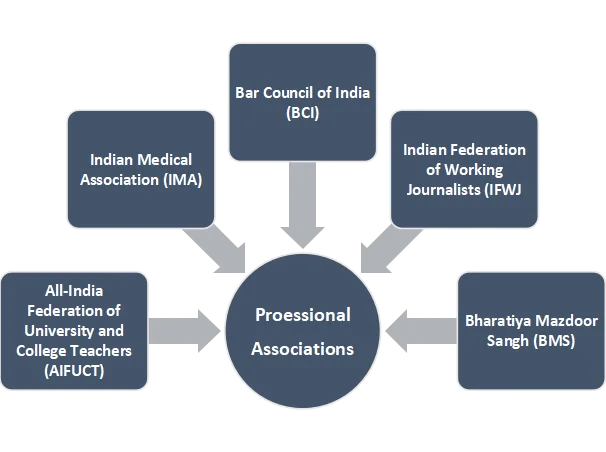
- Student Organisations: Various organisations have been formed to represent the student community. However, these are also affiliated to various political parties.
- Religious Organisations: These organisations based on religion play an important role in Indian politics. They represent the narrow communal interest.
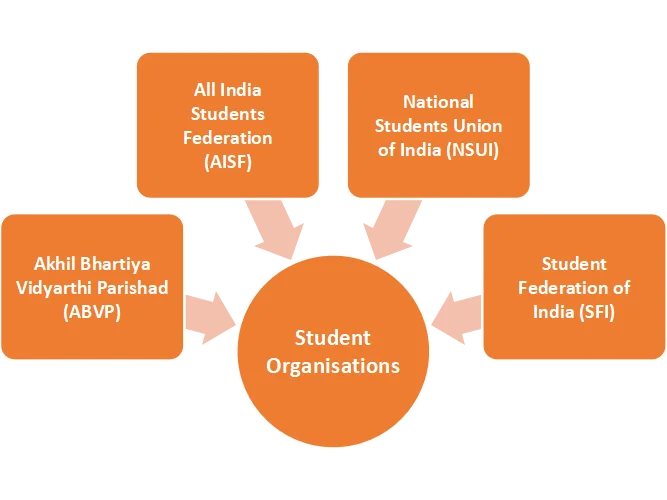
- Caste Groups: The competitive politics in many states of the Indian Union is the politics of caste rivalries:
- Brahmin versus Non-Brahmin in Tamil Nadu and Maharashtra, Ahir versus Jat in Haryana, versus Okkaliga in Karnataka, Rajput versus Jat in Rajasthan, Kamma versus Reddy in Andhra, Baniya Brahmin versus Patidar in Gujarat. Nair versus Ezhava in Kerala and Lingayat, Kayastha versus Rajput in Bihar.
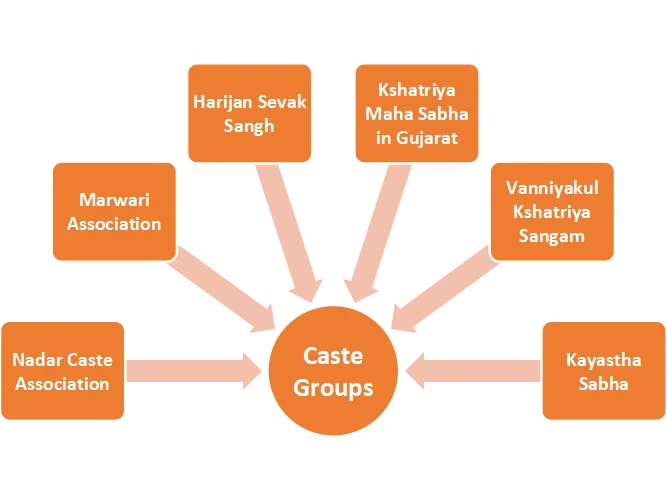
- Tribal Organisations: These organisations are active in MP, Chattisgarh, Jharkhand, Bihar, West Bengal and the North Eastern States of Assam, Manipur, Nagaland, and so on.
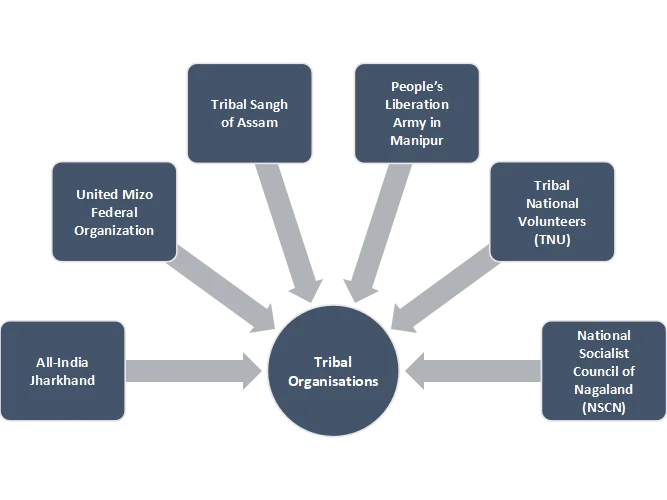
- Their demands range from reforms to secession from India and some of them are involved in insurgency activities.
- Linguistic Groups: Language has been such an important factor in Indian politics that it became the main basis for the reorganisation of states.

- The language has also been responsible for the emergence of political parties as well as pressure groups.
- Ideology-Based Groups: In recent times, pressure groups are established with the aim of advocating for a specific ideology, whether it be a cause, principle, or program.
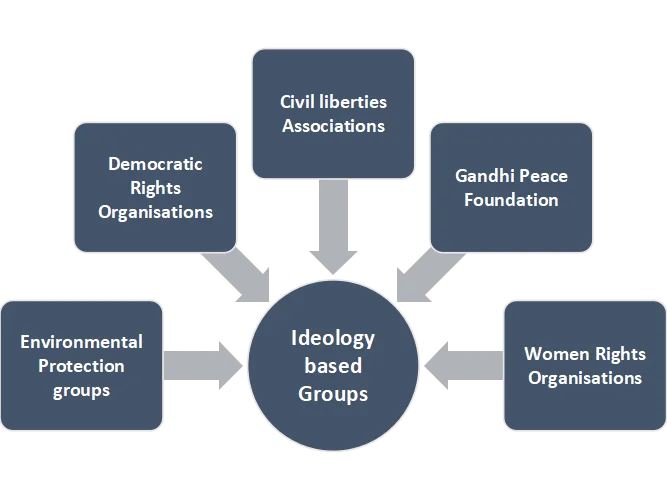
- Anomic Groups: Almond and Powell observed: “By anomic pressure groups we mean more or less a spontaneous breakthrough into the political system from the society such as riots, demonstrations, assassinations and the like.

- The Indian Government and bureaucratic elite, grappling with the challenges of economic development and limited resources, tend to adopt a technocratic and anti-political mindset.
- Consequently, demands of a particularistic nature are often denied legitimacy.
Enroll now for UPSC Online Course
| Must Read | |
| Current Affairs | Editorial Analysis |
| Upsc Notes | Upsc Blogs |
| NCERT Notes | Free Main Answer Writing |
Conclusion
Understanding pressure groups is essential to comprehend their significant influence on modern politics.
- These groups, whether formal or informal, institutional or anomic, play a crucial role in shaping policies, representing various societal interests, and reflecting the evolving consciousness of society.
Sign up for the PWOnlyIAS Online Course by Physics Wallah and start your journey to IAS success today!
| Related Articles | |
| Pressure Groups in Indian Politics | Reorganization of States |
| Bureaucracy: Permanent Executive, Feature and Role in Governance | Agricultural Development |

 GS Foundation
GS Foundation Optional Course
Optional Course Combo Courses
Combo Courses Degree Program
Degree Program












